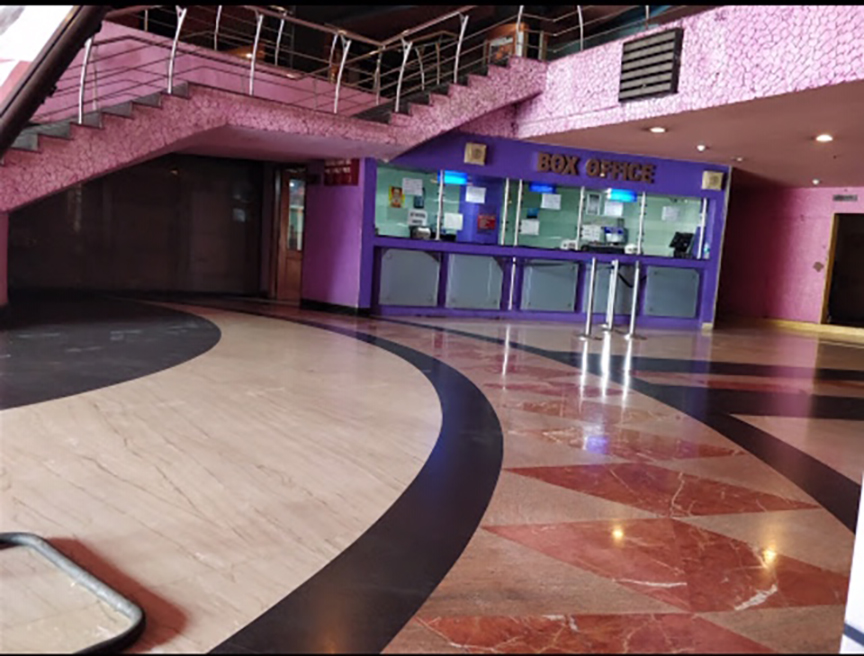Nearly two months into the lockdown, the multiplex cinema faces an existential crisis. The biggest fear is of a change in viewers’ habits, as they get addicted to online content
One of the three worst affected industries because of the lockdown due to Covid-19 is the film industry and the multiplex; the civil aviation and hospitality being the other two. Multiplexes were the first to be affected and will be last to restore their business.
There was already a one-quarter reduction in footfall as the infection spread and before the lockdown started. Now, in all likelihood, they’ll be the last to resume operations post lockdown.
Going to a cinema theatre is the antithesis of social distancing norms that will have to be enforced for months to come — until there’s a vaccine or a treatment for this pandemic. At the moment, the revenue is zero and many of the companies are trying hard to survive by minimising losses—even bigger companies like INOX, DT and Satyam.
The sector was doing well in the decade before the pandemic hit. There was a proliferation of multiplexes in metropolises, particularly Delhi. There’s hardly a locality in the capital where a multiplex is not in the vicinity of a 5 km radius. Dwarka too got its first multiplex this year.
It’s not just a question of loss of revenue from shut ticket counters. Big money is at play. Rs 15 crore plus is spent on the production of a decent movie. Cineplexes are equipped with state-of-art audio-visual systems, cushy seats, a ready supply of snacks and beverages. All of these are supplied by ancillary businesses.
The consumption of movies as a product has been revolutionised with the coming of multiplexes, as smaller halls with flexible timings are able to draw in enough crowds to keep the cash flow going. The experience for movie-goers is at par with the best in the world.
Multiplexes downed their shutters on 24 March. The content production and the money flow in the business via multiplexes were an integral to functioning of the whole ecosystem system of filmmaking. There has been a tussle between the two major stakeholders, the film producers and the multiplex management. Producers have an option to release films on over-the-top (OTT) networks but the multiplexes are reduced to ghost halls. Many of the producers are open to the idea of releasing a film directly on the streaming services like Netflix or Amazon Prime.

But if the multiplexes are to survive this crisis of pandemic, the whole sector will have to reinvent itself.
Alok Tandon, chief executive officer of Inox while speaking at a Retailers’ Association of India digital forum, articulated the worst fears when he said that the “multiplexes will in all likelihood, be one of the last businesses to reopen.” Not only that, it will call for a major change in the way malls operate, in the light of new practices of social distancing.
Clearly, this four-phase lockdown will result in a break from the past. There will be some crucial changes to be incorporated if the multiplexes are to re-open in the near future. Food and beverage menus have to be certified Covid-free. They will have to establish higher hygiene protocols and intermission timings will have to be staggered. There will be a need for some structural and architectural changes for “ensuring a safe movie experience, especially in the context of social distancing,” which would mean a system where there’s no queuing up, crowding at the ticket counters and food stalls, lesser crammed halls, bigger lobbies, adequate space between seats for safe viewing.
“It’s a matter of survival,” says Neeraj Chowdhury who owns Galaxie Multiplex in Sahibabad. The whole industry is worried as to incorporate all these changes will need huge investments at a time when the revenues have dried up. He informed that the multiplex association has petitioned the government for some relief. The fixed costs are huge, like the power charges, salaries of employees, GST, most of the equipment being on lease, annual maintenance contracts etc. The list is long.
“We have requested to the government that we should get a tax exemption for a year. And the fixed charges for power will be deferred till the business resumes.” he says.
He agrees with Tandon that the operations will start late, may be as late as September-October, and when it happens the halls will operate at half the capacity to meet social distancing criterion. “In any case, this business has low margins, a sizable part of the revenue comes during the weekends. Now with only 50% occupancy, profitability is going to take a big hit,” he fears.
Chowdhury is also worried that there would be restrictions on the cafeteria, which is a major source of revenue. The Multiplex Association of India (MAI) has also knocked the doors of the court against the various PILs which sought cinema-goers’ right to bring their food and beverages to the movie theatre. The Supreme Court has stayed the proceeding in a similar case heard by the Bombay High court.

- Chances are that the industry will bounce back within a few weeks after the restrictions are lifted.
Sanjay Mehta of Bobby Enterprises–film distributor and cinema controller (exhibitors) for Delhi, Uttar Pradesh and Uttarakhand circuit, presents a much more optimistic picture despite the crisis. He deals with the whole issue in two broad segments. First is the content creation and the second being the multiplexes.
As far as the content creation is concerned it has definitely been affected by the lockdown. “We will just need two to three weeks to put things together as far as the pending projects are concerned. Many of them are nearly complete, and are at the mixing and post-production stage.” Further, Mehta assures that there’s some 20-30 films lying in the inventory to start off. Then there are big-budget films, where the production cost is more than Rs 15 crore — they would not be in a hurry to release. These movies will wait for a conducive time. If need be, they will wait for a few more weeks after the lockdown is lifted and multiplexes are allowed to operate.
He regrets that a good time for new releases — summer vacations, with no major examinations — is lost to the pandemic. They are now looking at Dussehra, the beginning of the festive season, which peaks around Diwali, when many of the big budget films will be released.
Some 66 movies are waiting to be released that include Tom Cruise’s Top Gun: Maverick, Gal Gadot’s Wonder Woman 1984 and James Bond’s latest No Time to Die. Bollywood too has some big budget movies waiting in the wings, like Salman Khan’s Radhe, Akshay Kumar’s Laxmmi Bomb and Bachchan Pandey, Saif Ali Khan and Rani Mukerjee’s Bunty & Babli-2.
Mehta clarifies that the industry and the government are having dialogue online via Zoom to do what is necessary to safeguard the interests of all the stakeholders. Chowdhury points out that when the lockout is lifted, for it to be effective for the film industry it has to be pan-India. It will not work if only a few states allow screening of movies. Mehta agrees, “Most of the major states have to allow it,” he says. He speculates that multiplexed will be allowed to operate by June-end — an optimistic guess, for which they are keeping their fingers crossed.
Since there’s no denying the fact that multiplexes are in dire straits, yhe MAI has appealed to landlords across the country to waive off rent and common area maintenance, while it has also petitioned the government for various incentives and tax concessions.
Mehta, however, is optimistic that the whole industry “will bounce back” when the restrictions are lifted as India is “a country of cinema lovers.” He provides an audit of how things were to give an idea of how things would be. There’s a good case of some relief in GST and other fixed costs, and salaries are a big burden, and the government’s help would be a big support. But having said that, Mehta points out, that the multiplexes have operated with an average occupancy of seats of 40-50% in any case. The situation in single cinema halls is even worse: On an average, they had occupancy of 30% seats. It’s mostly a weekend business, when the rush of film fans peaks.
“The hardcore movie buff will continue to come,” he says, “and if the social distancing would restrict occupancy to 50%, we will still be fine,” Mehta asserts. For single hall theatres, an occupancy of 20-25% will get them back in the business.
- Changing habits: Now that people are forced to stay home, there’s a larger question of changing habits that worries the multiplex owners. Chowdhury fears habits will change as “people are getting excellent content online, and the home is safe.” He adds, “It remains to be seen how many people would want to risk watching a movie in a multiplex.” He recalls that there was a sizable reduction in the footfall this year even before the lockdown.
“Behaviour is changing,” says Siddhartha Upadhyay, a celebrated Delhi-based brand consultant. “Covid-19 has cemented the already changing behaviour.” He explains the nuance that people are getting choosy about the content they watch, which is also a reflection of the fact that they have so much to choose from. In a way, consumers are evolving as they want to be in control of what they are exposed to and in what way.
The trends, Upadhyay points out, shows the people like shorter versions of films — 21-50 minutes, rather than longer duration, two hours plus, of a feature film. The two leaders in the OTT network, Netflix and Amazon, have deep pockets and their financial capacity is better than any production house. Also, there’s a growing demand for shorter, detailed and well-made features. It’s not surprising that many of the mainstream movie production companies have tie-ups with OTT platforms to release their movies.

Sanjay Mehta of Bobby Enterprises is not convinced that this prolonged period of lockdown will alter the behaviour of the movie lovers in a way that will have a lasting impact on the business of the multiplexes or filmmaking. Watching content on a smartphone, laptop, or television is a very different experience than watching it on the big screen. Mehta points out, “70% of India still doesn’t have access to the internet and if one were to subscribe to all the main OTT networks, it would cost more than Rs. 4000 a month.”
Mehta concedes that some of the medium budget films might be tempted to release on OTT, but that’s not the case with big-budget movies. The net earnings still is Rs 40-50 crore more when movies are released on the big screen. And the option to later release on the OTT is not lost as has been the case with many big blockbusters in the past.
Mehta’s faith in India’s movie buffs is strong, as this is not the first time, and such challenges have been in the past as well. Like when the IPL was introduced, or when Buniyaad, Ramayan serials were telecast in the 1980s, people had questioned whether movies will retain their old charm. Also, there were challenges with the popularisation of videocassettes, DVDs, etc.
“Even before Covid-19, series like Narcos and Hindi series like Mirzapur or Sacred Games did very well. OTT has an advantage. There’s no censorship. And such series cannot be watched along with family or children,” Mehta points out. But what the big screen, especially in the multiplexes, has to offer is a very different experience. “It’s about the experience: 72 sound channels, larger-than-life visuals, unparalleled experience with 3D, 4D, and new breakthroughs coming.” And the film stars have an appeal of their own, though, lately, many established movie stars have opted to perform on the OTT platforms.
Given there’s an explosion of quality content, and OTT is better placed during the lockdown, and safety will remain a concern for moviegoers for many months to come even after the lockdown is over, the multiplexes and the big screen productions face a daunting challenge. But the challenge is an opportunity to improve, reinvent.
(Cover image: Galaxie multiplex has been shut since 24 March in view of the Coronavirus outbreak)





